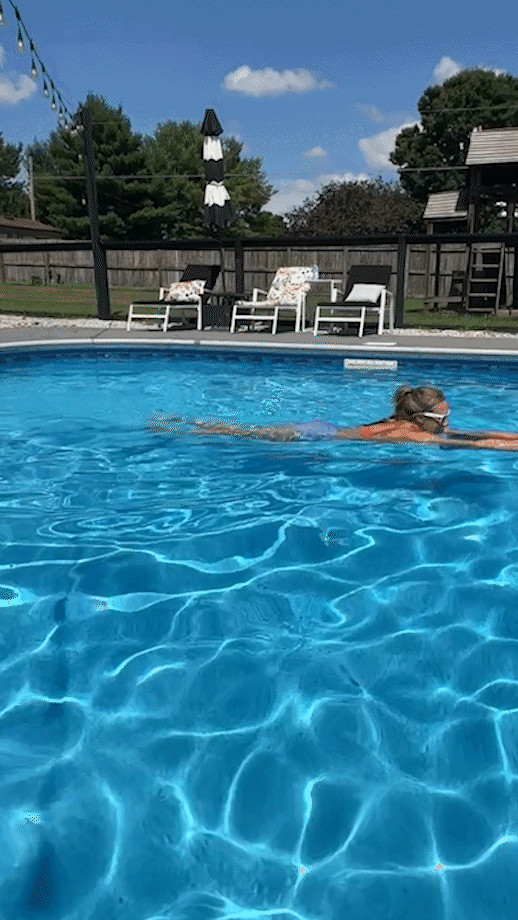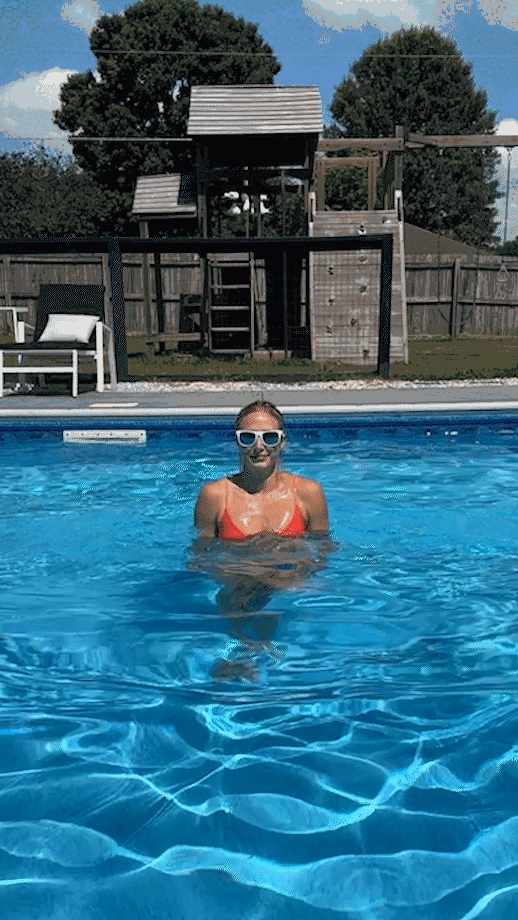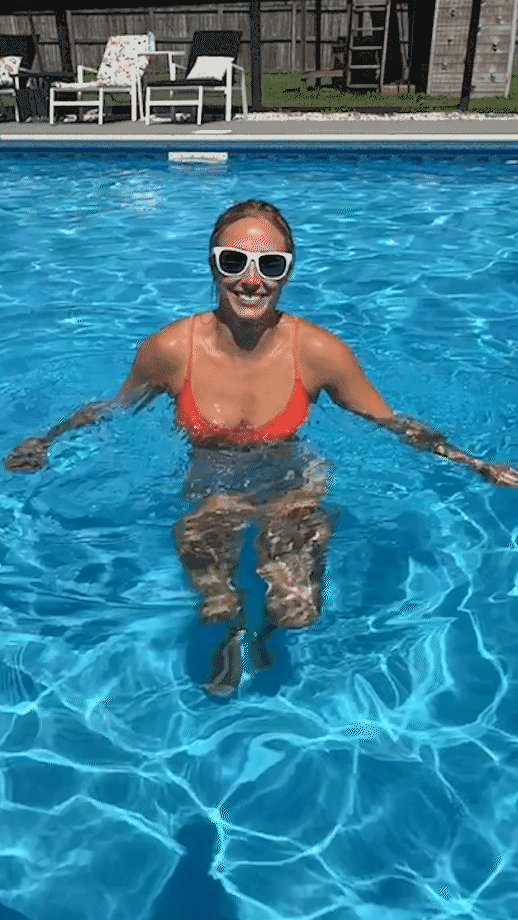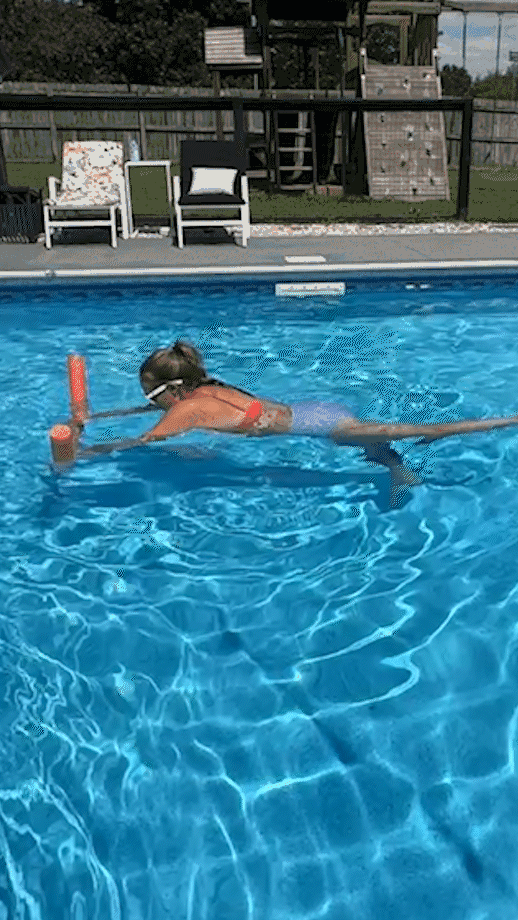Who says you need to stand on solid ground to get a great workout? As much as I love the familiar feeling of anchoring my feet to the floor to crank out a set of back squats or deadlifts, you don’t have to stick to the typical commercial or home gym setting to make progress toward your fitness goals.
In fact, switching up your environment can allow you to enjoy both physical and mental health benefits, such as learning a new skill set or improving your range of motion. As a certified personal trainer (CPT) and lifelong athlete, I believe balance is one of the biggest keys to successfully sticking to a workout plan. Putting this into practice doesn’t mean you have to ditch high-intensity gym sessions for pilates, however it does require a willingness to get your feet wet (figuratively and literally) with other training modalities.
RELATED: Best Pool Exercises
Whether you’re focused on a weight-loss goal, recovering from an injury, or simply looking for another way to burn calories that doesn’t involve a treadmill or elliptical, water aerobics exercises offer a ton of upside without some of the risks that come with CrossFit workouts and traditional land-based lifts.
Although you may associate aqua aerobics with baby boomers and older adults, don’t underestimate the impact of taking your workouts to the water. From dynamic upper body movements to ones that get your core muscles firing on all cylinders, I’ve put together a list of the 10 best water aerobics exercises so you can use a swimming pool to its full advantage.
10 Best Water Aerobics Exercises
- Water Walking
- Flutter Kicks
- Leg Lifts
- Wall Glides
- Jumping Jacks
- High Knee Jog
- Pool Plank (with noodle)
- Biceps Curls (with water weights)
- Pool-Edge Push-Up
- Squat
Water Walking
Muscles worked: Quadriceps, hamstrings, glutes, calves, core
Benefits: Walking may be the most basic cardiovascular exercise, but it’s not nearly as easy to move freely against the resistance of the water. Your leg and core muscles must work even harder as you get into the deep end of the pool. Increasing the pace from a walk to a jog will make this an even more challenging aerobic workout.
How to do it:
- Stand in chest-deep water with your body fully upright.
- Start walking through the water, letting your arms swing naturally by your sides.
- Continue for the target time or distance.
RELATED: Is Walking the Best Cardio?

Flutter Kicks
Muscles worked: Rectus abdominis, obliques, transverse abdominis, erector spinae, quadriceps, glutes, hamstrings, hip flexors
Benefits: A cardio- and core-focused aquatic exercise that targets your lower abs, hip flexors, quads, and glutes, flutter kicks can help you build strong legs and a strong midsection. Your erector spinae (lower-back muscles) must also remain engaged to keep good posture in the water as you kick your way down to the other side of the pool.
How to do it:
- Hold onto a kickboard or edge of the pool with your arms extended out in front of you.
- Extend your legs behind you, keeping them straight and as close together as possible.
- Engage your core muscles, keep a neutral spine, and begin kicking your legs up and down quickly in a controlled manner.
- Maintain a steady pace for the desired amount of time or distance.
RELATED: Best Pool Exercises for Abs

Leg Lifts
Muscles worked: Glutes, hip flexors, hamstrings, core, erector spinae
Benefits: A sedentary lifestyle can lead to weak, inactive glutes, opening the door to problems like lower-back pain and muscular imbalances. You can take care of that in the water by performing leg lifts—an exercise that’ll quickly get your glutes and smaller stabilizer muscles firing. Just don’t be surprised if you feel a deep burn within a few seconds.
How to do it:
- Stand in waist-deep water in the shallow end of the pool.
- Hold onto the edge of the pool with both hands so your arms are fully extended.
- Maintain an upright torso, engage your core, and kick your left leg out to the side until it’s at about a 45-degree angle.
- Squeeze your glute, then lower your leg back to the starting position.
- Repeat on the other side, alternating for the desired number of reps or time.
RELATED: Best Glute Workouts

Wall Slides
Muscles worked: Core, hamstrings, latissimus dorsi, deltoids
Benefits: Wall slides can help open up your lats and shoulders by putting them in a deep stretch position. At the same time, bending and straightening your legs will lengthen your hamstrings and work your core muscles, making this a valuable full-body exercise.
How to do it:
- Stand in chest-deep water.
- Hold onto the edge of the pool with both hands so your arms are fully extended.
- Place your feet on the pool wall and keep your knees bent.
- Extend your legs so you feel a stretch in your hamstrings and lats while engaging your core.
- Bend your knees to return to the starting position and repeat for the desired number of reps or time.
RELATED: Functional Core Exercises

Jumping Jacks
Muscles worked: Deltoids, latissimus dorsi, quadriceps, glutes, calves, trapezius, core
Benefits: No land or water aerobics class would be complete without this full-body cardio exercise. Jumping jacks are a great way to get your blood pumping and increase your heart rate, as your upper body and lower body must be in sync to keep things flowing smoothly. Hold onto a pair of foam dumbbells or attach water cuffs (pool-safe ankle weights) around your ankles to make this nostalgic movement more difficult.
How to do it:
- Stand in chest-deep water with your feet together and hands at your sides.
- Simultaneously jump your legs out while bringing your arms together overhead so your hands touch.
- Bring your arms back down toward your sides and your feet together to return to the starting position.
- Repeat for the desired amount of time or reps.
RELATED: Best Cardio Exercises at Home

High Knee Jog
Muscles worked: Rectus abdominis, obliques, transverse abdominis, erector spinae, hip flexors, quadriceps, glutes, hamstrings, calves, deltoids
Benefits: If you’ve played a sport at any point in your life, chances are you’ve performed high knees as a warm-up exercise or as part of a HIIT workout. This explosive plyometric movement isn’t exactly easy on land, as you must rapidly drive your knees toward your chest while maintaining a steady rhythm. Performing a high knee jog in the pool will get your fast-twitch muscles firing and quickly ramp up your heart rate.
How to do it:
- Stand in chest-deep water with your feet about hip-width apart.
- Explosively drive your right knee toward your chest while keeping your left foot planted on the bottom of the pool.
- Lower your right knee, then immediately drive your left knee toward your chest.
- Alternate sides and synchronize pumping your arms with driving your knees upward to stay in rhythm.
- Keep a steady pace for the target time or distance.
RELATED: Best Agility Exercises

Pool Plank
Muscles worked: Rectus abdominis, obliques, transverse abdominis, erector spinae, deltoids, rhomboids, trapezius, glutes
Benefits: This water-based plank relies on a pool noodle for support. Although this tool provides an assist, your rectus abdominis, erector spinae, and other core and lower back muscles still bear most of the responsibility for keeping your body as perfectly straight as possible. Whether on land or in the water, planking is a great way to support good posture.
How to do it:
- Stand in chest-level water.
- Hold onto a pool noodle placed horizontally in front of you.
- Extend your legs behind you so your body forms a straight line.
- Engage your abdominal and lower-back muscles, keep a neutral spine, and hold the plank position for the desired amount of time.
RELATED: 13 Plank Exercises and Variations

Biceps Curls (With Water Weights)
Muscles worked: Biceps, triceps, core
Benefits: Whether you’re doing #CurlsForTheGirls or just for yourself, you can bet your biceps will be on fire by the end. Using foam weights provides even more resistance against the water, giving this two-headed muscle a chance to grow bigger and stronger with each and every rep.
How to do it:
- Stand in chest-level water.
- Hold a pair of water weights by your side.
- Engage your core, maintain an upright torso, and curl the weights up to the surface of the water.
- Contract your biceps at the top of the movement, then slowly push down against the water to lower the weights back to your sides.
- Repeat for the desired number of reps.
RELATED: Hammer Curl vs Biceps Curl

Pool-Edge Push-Up
Muscles worked: Triceps, pectorals, biceps, rhomboid, trapezius, core
Benefits: Arguably the most popular bodyweight exercise, the push-up is a great way to build upper-body strength and size. Becoming proficient at this movement can also help you perform better at traditional lifts like the bench press and overhead press, which also require strong triceps and chest muscles.
How to do it:
- Stand in the shallow end of the pool and face the wall.
- Place your hands on the edge of the pool so they’re slightly wider than shoulder-width apart.
- Step back so your body forms a straight line from head to toe (like a plank).
- Slowly bend your elbows and lower your chest until you’re about 1-2 inches from the edge of the pool.
- Hold the position at the bottom for 1-2 seconds, then push through your palms to extend your arms and return to the starting position.
- Repeat for the desired number of reps.
RELATED: Push-Up Mistakes

Squats
Muscles worked: Quadriceps, glutes, hamstrings, calves, erector spinae, core
Benefits: The king of lower-body exercises, squats can be quite taxing on land—especially if you’re using heavy weights. However, the water-based version is much friendlier on your joints, making it suitable for people of all fitness levels and capabilities. While you can’t bring your barbell into the pool, you can increase the time under tension by pausing at the bottom of the squat.
How to do it:
- Stand in waist-deep water with your feet shoulder-width apart and toes pointed slightly outward.
- Extend your arms straight out in front of you.
- Descend into a squat position by bending your knees, driving your hips back, and maintaining an upright torso.
- Lower yourself down until your legs form a 90-degree angle.
- Push through your heels and extend your legs to return to the starting position.
- Repeat for the desired number of reps.
RELATED: Benefits of Squats

Sample Water Aerobics Full-Body Workout
Ready to put your upper body, lower body, and core to the test? This full-body workout requires a head-to-toe effort, along with a basic understanding of HIIT principles. Based on my experience as a CPT and athlete, I designed this session using the Tabata method—a highly effective protocol that typically includes eight rounds of 20-second work intervals and 10-second rest intervals.
To keep things a bit more manageable, I shortened that to four rounds for each exercise, giving you an opportunity to rest after completing the entire circuit. If you’re up for the challenge, repeat the circuit, or increase the number of rounds per exercise to test your cardiovascular fitness.

Before you dive in, however, I recommend water walking for at least 3 to 5 minutes to prepare your body for battle.
| Exercise | Work Interval | Rest Interval | Sets |
| High Knee Jog | 20 sec. | 10 sec. | 4 |
| Leg Lift (alternate sides) | 20 sec. | 10 sec. | 4 |
| Pool Plank | 20 sec. | 10 sec. | 4 |
| Squat | 20 sec. | 10 sec. | 4 |
| Pool-Edge Push-Up | 20 sec. | 10 sec. | 4 |
| Jumping Jacks | 20 sec. | 10 sec. | 4 |
| Biceps Curl | 20 sec. | 10 sec. | 4 |
| Wall Glides | 20 sec. | 10 sec. | 4 |
| Flutter Kicks | 20 sec. | 10 sec. | 4 |
RELATED: Tabata Cardio Workout
Benefits of Water Aerobics Exercises
Why make water-based exercises part of your workout routine? From being less taxing on your joints to offering the advantage of buoyancy, let’s explore the benefits of penciling pool sessions into your training plan.

Adaptable to All Fitness Levels
Water aerobics exercises can be as easy (or difficult) as you want them to be. Beginners or older adults can start with basic movements or modified versions that allow them to build strength, stability, and confidence. More advanced athletes have several options to make pool workouts more challenging, including adding resistance via foam dumbbells or water cuffs, increasing the time or number of repetitions, or decreasing the rest time between exercises.
Low Impact on Your Joints
Water workouts offer a huge advantage over traditional forms of cardio or strength training from a joint health perspective. While pounding the pavement on a long-distance run or pumping out reps on the leg press machine can take a toll on your hips, knees, and ankles, pool-based exercises are much more forgiving. According to a 2022 systematic review1, aquatic exercises are effective for reducing pain and joint dysfunction and improving quality of life in patients with osteoarthritis—an aging-related degenerative disease that typically affects the knee and hip joints.
RELATED: Best Low-Impact Exercises
Little to No Equipment Needed
Unlike CrossFit or powerlifting, aqua fitness doesn’t require much equipment other than the most obvious: a swimming pool. Instead of spending hundreds of dollars (or more) on the best Olympic barbell and set of the best weight plates, you only need a fraction of that to secure a kickboard, pool noodle, and set of water-safe dumbbells. In reality, you can crush a great workout in the water with nothing but your body weight.
Can Help You Lose Weight
Would water aerobics be my go-to form of exercise to lose weight? Probably not. Yet that doesn’t mean it can’t be a valuable part of your overall plan of attack to trim inches off your waistline.

A 2017 study2 on middle-aged, overweight women had participants perform two aqua power aerobics sessions per week for six months. In addition to improving their heart rate, the participants experienced positive body composition changes, suggesting that this form of exercise can be effective for treating weight issues.
RELATED: How to Lose Body Fat
Pool Exercises: Equipment Needed
Luckily for you and your financial health, you don’t need to dip too deep into your savings account to set yourself up for success in the pool. While you can perform most water aerobics exercises with just your body weight, here are a few items you may want to add to your shopping cart to make your workouts more dynamic:
- Pool Noodle: This lightweight, foam noodle can help you stay in the proper position for exercises like pool planks and bicycle kicks. Best of all? You can find one online or at major retailers like Walmart or Target for just a few bucks.
- Kickboard: A versatile piece of equipment that’s also fairly easy to find, a kickboard offers security and an avenue for more resistance. You can hold onto one for core exercises like flutter kicks, or submerge it under the water for strength training movements like chest presses.
- Water Shoes: There’s nothing worse than getting out of the pool only to realize you’ve torn up the bottom of your feet. Keep your soles protected with a pair of specialized shoes that enhance your grip and prevent blisters, cuts, or scrapes. Investing in a pair of water shoes is especially useful if you enjoy other water-based activities like paddleboarding, kayaking, boating, and fishing. While higher-end models can cost over $50, you can find plenty of budget-friendly options around the $10 mark.
- Foam Aquatic Cuffs: Just like you can use the best ankle weights on land to add resistance, you can rely on foam aquatic cuffs to make water-based exercises more challenging, too. You can even attach them around your arms to take jumping jacks or treading water to another level.
- Foam Water Weights: Although you won’t find heavy versions like you would with traditional dumbbells, foam water weights (also referred to as aquatic dumbbells) provide resistance under water for exercises like biceps curls, lateral raises, and triceps kickbacks. They’re typically made from non-absorbent EVA foam and cost around $25.
RELATED: Best Adjustable Dumbbells
Water Aerobics Exercises: Final Thoughts
One thing I’ve learned over the years as an athlete is to never knock something until you try it. Even if you think water aerobics is too easy or not intense enough to be effective, I encourage you to try my sample workout and see whether you’ve been underestimating swimming pool sessions.
That being said, I look at water-based exercises as a complementary piece of the health and wellness puzzle. You should still prioritize strength training, active recovery, and following a well-balanced, protein-focused diet. But, as I mentioned in the intro, balance is key. Spending some time working out in the water may just be the ideal avenue to help you keep this all-important concept afloat.
Water Aerobics Exercises: FAQs
How many times a week should you do water aerobics?
As a CPT, I recommend doing water aerobics once or twice a week as a low-impact form of cardio. This can provide much-needed relief for your joints, especially if you perform strength training workouts on a consistent basis.
Can you lose weight doing water aerobics?
Yes, you can use water exercises like flutter kicks, high knee jogs, and squats to help you burn calories and lose weight. However, you must be in a calorie deficit to see the number on the scale go down, which makes your nutrition equally as important as your training.
What burns more calories walking or water aerobics?
According to Harvard Health3, a 185-pound person can burn about 189 calories during a 30-minute walk at a pace of 4 mph. That same person can burn approximately 168 calories during a 30-minute water aerobics session, making walking slightly more productive from a calorie-burning perspective.
How long does it take to get in shape with water aerobics?
While your diet and training intensity play significant roles in how quickly you can get in shape, a 2018 study in the Public Library of Science4 found that 12 weeks of water aerobics performed twice a week produced positive changes in explosive strength, body composition, and blood pressure of adults and older adults.
References
- Song JA, Oh JW. Effects of Aquatic Exercises for Patients with Osteoarthritis: Systematic Review with Meta-Analysis. Healthcare (Basel). 2022 Mar 16;10(3):560. doi: 10.3390/healthcare10030560. PMID: 35327038; PMCID: PMC8955208.
- Bielec G, Kwasna A, Gaworska P. The influence of Aqua Power aerobics on body mass reduction in middle-aged, overweight women. Turk J Phys Med Rehabil. 2017 Nov 13;63(4):293-298. doi: 10.5606/tftrd.2017.853. PMID: 31453470; PMCID: PMC6648080.
- Harvard Health. (2021, March 8). Calories burned in 30 minutes for people of three different weights. https://www.health.harvard.edu/diet-and-weight-loss/calories-burned-in-30-minutes-for-people-of-three-different-weights
- Pereira Neiva H, Brandão Faíl L, Izquierdo M, Marques MC, Marinho DA. The effect of 12 weeks of water-aerobics on health status and physical fitness: An ecological approach. PLoS One. 2018 May 31;13(5):e0198319. doi: 10.1371/journal.pone.0198319. PMID: 29851998; PMCID: PMC5978883.







